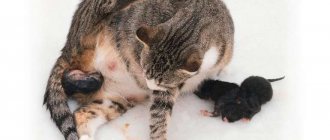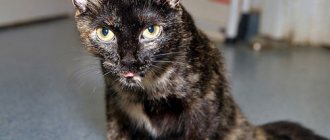Reproduction is no less important a natural process in the life of animals than, for example, nutrition or growth. While protecting the health of their beloved pet, owners often face the problem of continuing the cat family. At the same time, when the animal is about to give birth, the whole family panics, because what to do if the cat needs help?
The role of owners in the cat's birth process
As a rule, the birth of cute fluffy creatures takes place at home. If there are no complications and everything is fine with the cat, then she is quite ready to give birth on her own, she does not need any outside help, even if she is bringing kittens for the first time. But in cases where there are even the slightest risks to the health of kittens or the expectant mother, it is better to go to a veterinary clinic, where doctors will reduce all possible threats to a minimum.
An important and necessary support for the animal will be the presence of caring owners, who must always be ready. Cats give birth approximately 60-70 days after conception, so there is plenty of time to prepare in any case.
Signs that the process of labor in the pet will soon intensify appear within a week. You need to remain extremely attentive to your pregnant cat and constantly monitor her condition. If the animal gives birth repeatedly, then perhaps with some experience, recognizing feline signs of prenatal behavior is much easier. But how can you tell that a cat is giving birth when it’s her first time? What should the owner do to ensure that the furry pet gives birth without complications?
How is the pregnancy period going?
The owner of the cat can calculate in advance the approximate date of labor. Pregnancy in animals lasts about 60-65 days. Full-term kittens are born healthy.
If a cat exhibits pathological signs during pregnancy, there is a chance that labor will begin ahead of schedule. To ensure that your pet bears a healthy litter and her pregnancy does not end tragically, be sure to show the cat to the veterinarian throughout the entire pregnancy. This is especially true if pregnancy occurs with complications.
How many babies do cats usually give birth to at one time?
To begin with, you should not panic. The harbingers of this wonderful event will help you find out about the preliminary date of birth of the kittens. As a rule, contractions begin in an animal after one or two days of intense tossing and active searches for a suitable place for future offspring.
Quite often, cats have from 1 to 6 kittens in one litter. Of course, it's different for everyone. Determining the main factor that influences brood size is not easy. Basically, it all depends on:
- state and characteristics of the animal’s body;
- hormonal balance;
- age;
- weight.
From the very beginning of pregnancy, fertilized eggs are attached to the uterine walls, where new cat lives undergo the entire development process. By the way, when they reach 6-8 months, cats are considered sexually mature. But quite often animals are not ready to bear full-fledged and healthy babies at this age.
Many owners are interested in how many kittens a cat can give birth to. After all, often only a few owners can keep all the fluffy balls for themselves. You will have to take care in advance about further shelter for the kids. But if you know that the first time a cat brings a maximum of three individuals, then you can wait with the selection of options for their subsequent place of residence.
An interesting detail is that at an older age, a cat also quite often gives birth to no more than 2-3 cubs. Such births in cats are difficult, and every year the interval between the next litter is reduced, gradually disappearing. Over the age of 9-10 years, furry pets generally do not bear offspring.
Preparation
The owner of a cat is obliged to prepare for her birth. The first step is to prepare a nest with low sides in which lambing will occur. To avoid injury, the cat must freely get out of the box without touching its edges with the mammary glands.
Nest for a cat with kittens
A prudent fellinologist is obliged to agree in advance with a veterinarian to provide assistance during childbirth or conduct consultations by telephone. The following tools should be on hand:
- Veterinarian contact number.
- Aseptic gloves.
- Pipettes.
- Sterile thread.
- Disinfected scissors.
- Antiseptics.
- Box for newborns with a heating pad.
- Gel lubricant to facilitate the exit of the fetus from the birth canal.
- Clean cotton diapers.
- Cat milk replacer.
Thermometry
A responsible cat owner should perform thermometry on a cat who is about to give birth. 1…3 days before lambing, T° drops below 37° C. At this time, the cat actively licks the genitals. The expectant mother becomes isolated in her own experiences.
Arching your back signals that contractions will occur in 4...8 hours. The animal is worried, meows invitingly, calling its owner, or hides. Lost appetite. The cat independently chooses a place for lambing; it is impossible to convince her otherwise, so you should arrange a place that your pet likes. Firstborns can kitten anywhere, scattering kittens throughout the apartment.
How does the approach of labor appear?
So, the cat has been pregnant for about two months and the date of birth of the kittens is approaching, and with it the tension of the worried owners is increasing. How to understand that a cat is about to give birth is absolutely easy. Paying close attention to the main signs of the onset of labor in an animal, it is easy to notice how labor begins:
- The cat loses its appetite, it becomes motionless, lethargic (a clear indicator that in just a few hours it will be possible to give birth to your pet).
- Actively searching for a secluded place or, conversely, arranging a visually accessible area for the owners to view (meanwhile, it is better to determine the area for a long process in advance, although there is no guarantee that the animal will approve of it).
- Signs such as the release of a mucus plug and the appearance of vaginal discharge are indisputable proof that childbirth will be possible soon, literally in two to three hours.
- Your pet is about to give birth if her nipples are swollen and colostrum is released from them.
It’s easy for women to imagine how cats give birth, because they probably had to directly or indirectly face such a question. But when the mission of an assistant in the process of giving birth to kittens is entrusted to a man, he will have to familiarize himself with some features of the physiology of tailed animals so as not to make mistakes if necessary.
Signs that labor has already begun
If you are reading this article and do not see the first signs, then most likely the birth process has already begun. The animal's body prepares in the same way as the human body: the cervix opens and contracts. This stage goes unnoticed by the owners, but can be determined by an experienced veterinarian.
Evidence that replenishment is imminent:
- The animal tries at any cost to get to the place that it found in the house and chose for the birth stage: it does not sit in its arms, snarls and returns to its “nest”. Don't worry if your pet refuses to eat during this time. Place clean, warm water and light, low-fat food nearby. In general, here is a separate article about what to feed your cat, read it.
- The birth plug has come out - a pink bubble, at first glance, and a red clot if the plug has already come out. You can see it on the litter or notice it already when the cat eats it.
- An abundance of mucous amniotic fluid of a yellow tint. If the animal is already in place, you can determine the fluid output by touching the bedding. If the litter is damp, replace it. In general, I advise you to purchase a disposable diaper in order to quickly and efficiently provide comfortable conditions for the cat.
These are three sure signs that birth is near. After the release of amniotic fluid, the appearance of the first kitten can be expected within several hours. Watch Athena's video, she explains all the points, showing on her cat:
If you have anything to add, please write in the comments. At this crucial moment of replenishment, any advice will come in handy.
How does this happen?
After the first contractions have occurred, you need to understand that the process is nearing its end. But before active labor and immediate pushing, the pet will have to endure a lot. In general, it is convenient to divide what is happening into several stages:
- Opening of the birth canal and cervix (if the cat’s water breaks, this indicates the onset of labor).
- Birth of kittens (the birth interval for each of the litter's cubs is normally from 15 minutes to half an hour).
- Exit from the uterine cavity of the placenta.
Before you give birth to a cat, you need to prepare additionally. Definitely, you need to be prepared for the fact that you may need additional materials and simple pharmaceuticals. Before labor begins, it is important to have on hand:
- clean gauze;
- pipette;
- petrolatum;
- scissors;
- heating pad;
- towel.
Initial stages of labor
You should not rule out the possibility that you will have to call a veterinarian if something goes wrong. Labor in cats usually lasts about 12 hours. As with women, the first time for furry pets often takes a long time and is much more painful. The initial stage can make up most of the entire period of labor.
Contractions cause discomfort in the animal, it begins to breathe quickly and behave restlessly. But it is important to know that it is absolutely forbidden to shout at a cat in such a state, no matter what it does. It is necessary, first of all, to calm the pet down and give it the opportunity to feel protected.
How to help a cat in case of weak labor?
When labor does not activate for quite a long time, especially if the cat’s water broke about 30 minutes ago, it is urgent to take serious action and induce labor. This should be done without unnecessary hesitation, however, even a chaotic rush can only harm the pet.
Here's how you can help your cat:
- The owner's fingers should be lubricated with Vaseline.
- Gently insert your fingers into the vagina and begin to slowly pull out the kittens.
- The cat's belly must be supported with your free hand.
- If the contraction stops, it is important to massage the back and stroke the stomach, stimulating the appearance of new attempts.
- Under no circumstances should you pull the kitten by the head. Otherwise, you can break his cervical vertebrae, which, naturally, will lead to death.
It is not difficult to induce labor, but it is advisable to resort to such a procedure only in exceptional cases.
Immediate birth of babies
Cat birth moves to the next stage when the amniotic sac ruptures. The discharge of amniotic fluid helps to lubricate the vaginal passage. Usually a few minutes pass between the rupture of the amnion and the birth of the first baby. All cats have completely different durations for such breaks: for some, everything goes away in 5 minutes, while other animals give birth to their kittens in up to half an hour. But it is important to know that the time interval between the birth of the remaining cubs should not exceed a 30-minute pause.
A cat gives birth to kittens within 2-4 hours. Then a completely natural process continues, which does not require any human intervention. There is no need to do anything, because on an instinctive level the animal itself must accept its offspring. The mother quickly licks the face of each kitten as each of them is born, gnaws the umbilical cord and removes the amniotic membranes.
The third and final stage of labor involves the separation of the placenta, which comes out on its own a few minutes after the kitten is born. Many owners may not know that cats usually eat placenta. In addition, after such “food”, young mother cats may develop gastrointestinal upset.
Childbirth for the first time - features
The behavior of first-time cats is always unpredictable. Many years of experience of breeders and owners have made it possible to identify some patterns of events if a cat gives birth for the first time. Primiparous cats are more emotional in everything: they meow more, caress more, panic more, etc.
Primiparous cats arrange the nest much in advance (1–2 weeks before giving birth), or “forget” about this ritual. Many owners note that 10–12 hours before giving birth, the cat categorically does not let go of its owners and meows loudly if it is left alone.
Note! Primiparous cats are more likely to panic during training contractions because they cannot distinguish them from real ones.
After giving birth, the behavior of primiparous cats is also unpredictable. A young mother will worry about the safety of her offspring and may carry kittens several times, protect them from annoying attention, and even hide them.
Not all kittens were born: what to do?
Sometimes the process of giving birth to furry babies drags on for a long period. This often happens for the first time in cats, and even more often in the case of numerous offspring. Is it possible to use some signs to understand whether all the kittens have been born or not? What should you do if one or more babies remain in the womb, and the cat is not going to give birth anymore? The following manifestations may be reasons for concern:
- the animal behaves strangely;
- when palpating the cat’s abdomen, a lump is felt that is the size of a kitten;
- the size of the abdomen does not decrease;
- body temperature rises to 39 degrees;
- A greenish fluid is released from the vagina.
It often happens that a cat takes a “time out” after the birth of 4-5 kittens. During the rest period, she begins her new maternal responsibilities of caring for the already born babies, and after a certain period of time, the cat cubs temporarily remaining in the womb will be born. In this case, you should not worry.
However, if one of the above signs is present that there is a kitten left in the pet’s womb, the owner’s actions should be clear: it is necessary to urgently contact specialists. You cannot hesitate, because you will have to save not only the fetus, but also the cat.
First signs
Friends, first of all, I recommend turning to your memory and remembering when the mating occurred. Pregnancy lasts 65-70 days and even if you do not know the exact day of conception, an error of a few days will not be critical. This is the first actual sign that birth is near.
The second sign of an approaching replenishment is the pet’s changed behavior.
In about 2-3 days, the animal will actively look for a place to give birth, choosing darkened corners, a pile of clothes or a recessed place in the closet. Do not disturb your pet, but offer a more equipped option - a box or drawer with a disposable diaper lined with it.
The third symptom can be considered a change in body temperature. The usual temperature in cats does not exceed 39 degrees. As labor approaches, the temperature may drop to 37 degrees. Check out this article on how to measure your cat's body temperature.
The fourth sign of approaching labor will be the appearance of colostrum. It's easy to check. Look to see if the animal's mammary glands have enlarged. Usually the nipple swells and becomes a soft pink color. Pressing on the nipple may release colostrum.
The fifth point is active licking of the genitals and fur.
If the cat behaves unnaturally, cannot sit in one place, or hunches over, most likely you are seeing the sixth symptom of labor - training contractions.
It is important to know that these “markers” may be present together, or they may be completely absent. The only accurate way to determine the approach of labor is to calculate it from the day of mating.
Maternal care
As a rule, there are no special recommendations for caring for healthy, newly born kittens with a mother present. The programs of maternal instincts in cats are laid down at the highest level, so it is better to take care of a pet who has devoted a lot of effort to the complex birth process.
Once a cat begins to feed its cubs with milk, it needs good nutrition, rich in proteins, vitamins and beneficial microelements. If there is an acute issue about the distribution of offspring, babies can be taught to eat independently from the age of three weeks.
Possible problems during childbirth
In medicine, difficult births are called pathological.
The first pathology is a violation of the position of kittens before birth. Presentation can provoke birth injuries and pathologies in the future. This is preceded by a lack of calcium, as the cause of asynchronous contractions of the uterine muscles.
This pathology can occur during contractions (first stage), then when the body begins to push out the fetus (second stage), and when the kitten emerges from the genital opening (third and final stage). The animal may hiss and scream loudly.
Note! In purebred cats (Bengal, Fold, British, Scottish, and so on), problems and pathologies are more common than in outbred cats. Therefore, veterinarians strongly recommend seeking regular diagnostics.
And during pregnancy, a specialist will tell you whether pathology should be expected and what kind. Obstetrics may be required.
The second pathology is more related to the cat itself. If the postpartum membranes do not come out during childbirth, they will cause apathy and a bad mood for the cat. The consequence of this will be refusal to care for children, bad mood, lack of appetite and brown discharge. True, for Thai and Sphynx cats, discharge and licking are not always a symptom, because the nature of the animal differs from simpler cats (British or Scottish, for example).
Obesity
These are just 2 of the most common pathologies; they can be caused by poor health, obesity, large fetuses and dozens of other reasons. As a rule, most pathologies can be detected by ultrasound.
Video
False pregnancy in cats
False pregnancy is a pathological condition of an animal in which it believes itself to be pregnant, but is not. In this case, all the signs of pregnancy may appear: nipples swell, colostrum is released, behavior changes, the cat may begin to build a nest.
This happens under the influence of the production of sex hormones. In advanced cases, an increased amount of colostrum can affect, for example, the formation of mastitis.
Any such condition is stressful for the animal and can ultimately lead to many pathologies. And if before this you did not want to sterilize your cat, the manifestations of a false pregnancy should make you think and take your cat for sterilization. After all, in the future you can get diseases such as pyometra, ovarianitis, endometritis and breast cancer with the highest percentage.
Early neutering can prevent all of these pathologies if the cat never gives birth. Remember that every time a cat goes into heat, it experiences severe stress, which, in addition to wasting hormone production, triggers other pathological processes.
In case of false pregnancy, it is important to consult a veterinarian for advice - he will tell you what medications should be given to reduce the production of colostrum, and prescribe additional treatment, if necessary. On your part, you need to limit your cat's stress and reduce fluid intake.
“It would be good to try to distract the cat from her thoughts about pregnancy, for example, to play with her more often,” advises veterinarian Marina Mikheenko .
By the way, there is an opinion among people that a cat should be allowed to become pregnant and give birth once, so that it can bear offspring and be immediately sterilized. In fact, mating a cat before sterilization is not contraindicated - this can affect both the health and psyche of the animal. The most favorable age for sterilizing a cat is after puberty, which occurs at 10 months (2).
How to prepare a nest for a cat?
A nest is a place where a cat gives birth and raises kittens. Kittens stay there for up to 1-1.5 months. It is best to use a cardboard box without foreign odors as a nest. Boxes of strong-smelling household, paint, and perfume products will cause rejection in the animal.
Boxes of aromatic food products - sausages, cheeses, fish - are also not suitable. Cardboard should not smell like anything.
At the bottom of the box you need to put several waterproof diapers - veterinary, children's or surgical. During the birth process, one or two of them will be wet and soiled with amniotic fluid, mucus, and blood.
Dirty and wet diapers will need to be removed and left clean and dry. It is advisable to keep the diapers that were already at the bottom of the box at the time of birth, since they will retain the smell of the cat, and she will not be nervous about changing the bedding.
Cat houses are not suitable as a nest. It will be difficult to wash them off from mucus and blood. In addition, in the house it is difficult to observe the giving birth and provide assistance to her.
If there is no nest, the cat can settle in the closet on clothes, on the sofa on bed linen or on the kitchen table. Then she will bring the born offspring there, risking the destruction of the litter.
How can a person help?
It is worth noting that all purebred cats have a reduced instinct, so they will need your help. The main ways a person can help:
- Prepare the area for lambing. A medium-sized, open-top box is best.
- Line the box with disposable diapers and change them when dirty.
- Have scissors ready in case the mother in labor does not gnaw the baby's umbilical cord herself.
- Purchase in advance a medicine that helps labor - calcium gluconate.
- You should always have a veterinarian’s phone number at hand so that you can get qualified advice and help from him if necessary.
- During lambing, make sure that the pet does not crouch. Lay her on her side, stroking her stomach and back.
- Provide the nursing animal with a complete, balanced diet.
Having safely experienced an important moment in your cat’s life, try for the first time, if the pet copes well with its maternal responsibilities, not to touch or pick up the babies.











